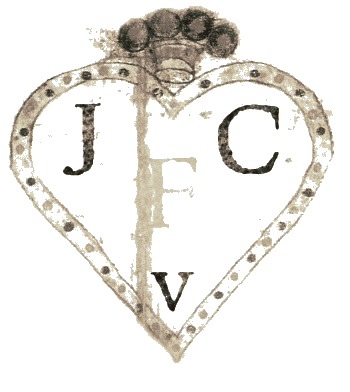|
History
Tradition says that this church was founded in the 9th
century, but the earliest written record is dated 1161. It was dedicated
to Saints Pantaleon (the name means ‘all-compassionate’) and Giuliana, but became plain San Pantalon
in Venetian dialect. The
church was rebuilt, and reconsecrated in 1305. The Barbari map of 1500
shows its façade facing Rio de San Pantalon, as does the Merian map of
1635 (see below).
Later an entrance facing onto the campo was
added, but when the church was rebuilt in 1668-86 by Francesco Comino the
church's orientation was rotated by 90 degrees so that the (still
unfinished, looming brick) façade faced the campo, which was long used as
a fish market. It is said that Comino's plans for the façade had been
inspired by the church of the Redentore and San Lazzaro dei Mendicanti.
Saint Pantaleon, a martyr saint more popular in the East, was a 3rd-century
doctor from Nicomedia and became famous in Venice in the 18th century due
to a play written by Goldoni.
Interior and art highlights
The church is big and tall and aisleless, with three
deep intercommunicating chapels on each side down the nave.
The problem with this church is gloom, it has to be said - it's a dark
church with very sparse lighting, a situation made worse when it was only
open in the evening. But once your eyes acclimatise the ceiling reveals itself
as something very special.
This is a very
Baroque ceiling by Giovanni Antonio Fumiani, done between 1680 and 1704,
depicting scenes from The Martyrdom and Glorification of St Pantalon
amongst looming illusionistic architectural perspectives. It's the largest
oil painting in the world, supposedly, measuring around 443 square feet
and made up of 40 canvases sewn together. Ruskin found it vulgar,
unsurprisingly. The artist is said to have fallen to his death from the
scaffolding here whilst painting, but the
fact that he died in 1710, six years after the painting was completed,
would seem to refute this story.
More of his work can be found in some of the other chapels here
and he was buried in this church, although a recent
(October 2016) visitor was told by an attendant that he wasn't.
Down the left side the first, Chapel of the
Immaculate Conception, has an Immaculate Madonna with the Archangel
Michael and Saint Anthony of Padua of c.1710 by Nicolò Bambini. The
second is the Chapel of the Lady of Sorrows (Addolorata) which has a
Deposition by Fumiani from c.1700. The third is the Chapel of the Holy
Trinity with a Holy Trinity with the Virgin and Saints John the
Baptist, Peter, Anthony
and the Guardian Angel by Gregorio Lazzini from 1723.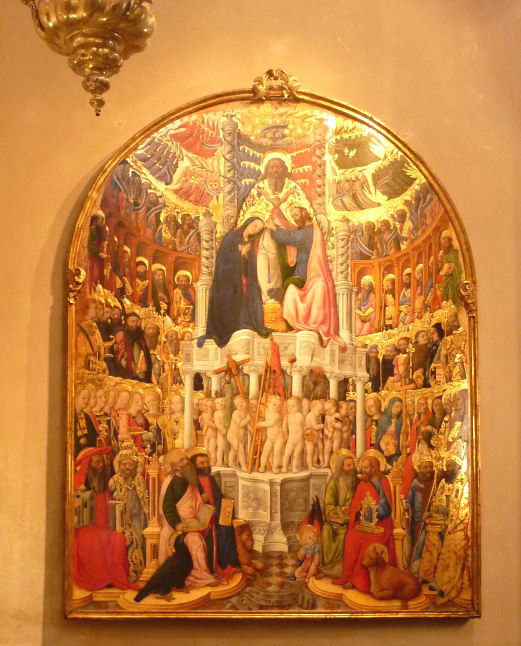
To the left of the high altar there
is access to two highlight chapels. The first is the Capella del
Sacro Chiodo (Sacred Nail) added in 1722, and named for the relic donated
to the church by the last abbess of the Clarissan convent of
Santa Chiara.
The chapel has a late-14th-century altar and Virgin and Child
statue, the former is Venetian the latter French. It contains a mighty impressive large
panel of The Coronation
of the Virgin with Saints and Prophets by Antonio Vivarini and
Giovanni d'Alemagna (see right) which formerly hung to the left of
the high altar.
There's also the Madonna of the Poppy (Papavero),
with The Annunciation, Nativity, Presentation at the Temple and
Dormition (aka The San Pantalon Dossal). This has been dated to
c.1321-33 and used to be attributed to Paolo Veneziano. It is now given to
The Master of the San Pantalon Dossal, an artist who was probably
connected to Paolo, maybe even one of his sons, or his father.
Further down a short
corridor is the Capella della
Santa Casa di Loretta built in 1744. This is medium-sized, dark and brick-walled (see
below right) with some sweet fragments of frescos of the Virgin and
Child with Saints and Angels by Pietro Longhi from around 1745.
The presbytery has a high altar of 1668-71 by Giuseppi Sardi and a
Triumph of the Eucharist painted by Fumiani in the vault. The original
high altar had been the work of Andrea Palladio from 1557, his first
commission in Venice, but was lost during the 17th-century rebuilding.

The third highlight chapel
on the right is the large central one, dedicated to San Pantalon.
There's a grand Paolo Veronese
altarpiece here (see
right) The Miracle of San Pantalon
which he began painting a year before he died
and which is his last known work. It was commissioned by Bartolomeo Borghi,
the pievano (parish priest) in 1587 and includes his portrait as
the priest supporting the boy who has been killed by a snake bite. The
saint is shown curing the boy with prayer whilst ignoring the proffered
medicine box. The snake, looking more like a small dragon, is seen making off
the bottom right-hand corner. Although commissioning such a work might
strike us now as an act smacking of self-importance and vanity it would
probably have been seen more as an act of piety at the time. This painting
was originally over the high altar, which was Palladio's first work in
stone in Venice, long lost, with no visual record remaining. When the axis
of the church was twisted through
90°
in the 17th century the painting kept its west-facing orientation, now being in a
chapel in the centre of the right-hand aisle. The Miracle of San Pantalon
was restored by Venice in Peril for the
Genius of Venice exhibition at the Royal Academy in London in 1983 and
it came over for the big Veronese exhibition at the National Gallery in
2014. If you saw it then, lucky you - you saw it up closer and much better-lit
than you do in the church.
The saint heals a paralytic and is decapitated
in the flanking panels by Palma Giovane, with the lunette on the left by
Lazzarini and on the right by Fumiani, along with the dome, depicting more
scenes from the saint's life.
Ridolfi mentions another work by Veronese,
painted for the Lanaiuoli, depicting San Bernardino, which
is likely the
painting of this saint in the chapel to the left, dedicated to him, now
attributed to Alvise Benfatto del Friso from the late 16th century.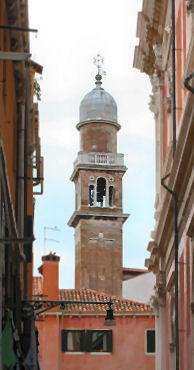
Ruskin wrote
Said to contain a Paul Veronese; otherwise of no importance.
Campanile 47m (153ft) manual bells
The original church's tower was restored 1225 and demolished in 1511 after
an earthquake. The current tower
was built 1704-32 by
Giovanni Scalfarotto. It has a neo-classical belfry with a tall circular
drum above and an
elongated dome. To me it looks a lot like a vibrator, I'm sorry. It has
had scaffolding covering it in recent years, but is now scaff-free and
clean.
Opening times
Monday to Saturday:
10.00 - 12.30 & 3.30 - 6.00
(until 7.00 on Tuesday, Thursday and Saturday)
Sunday: 9.30-12.30 & 3.30-6.00
The church has a stylish
website
Vaproretto
Ca' Rezzonico
map |
|
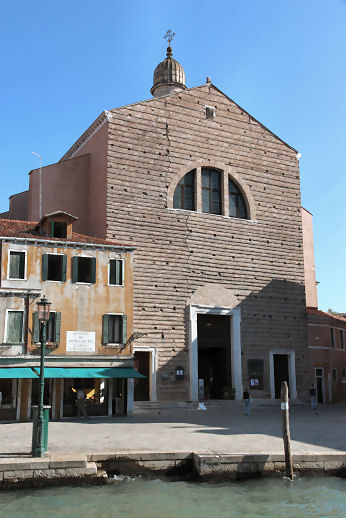
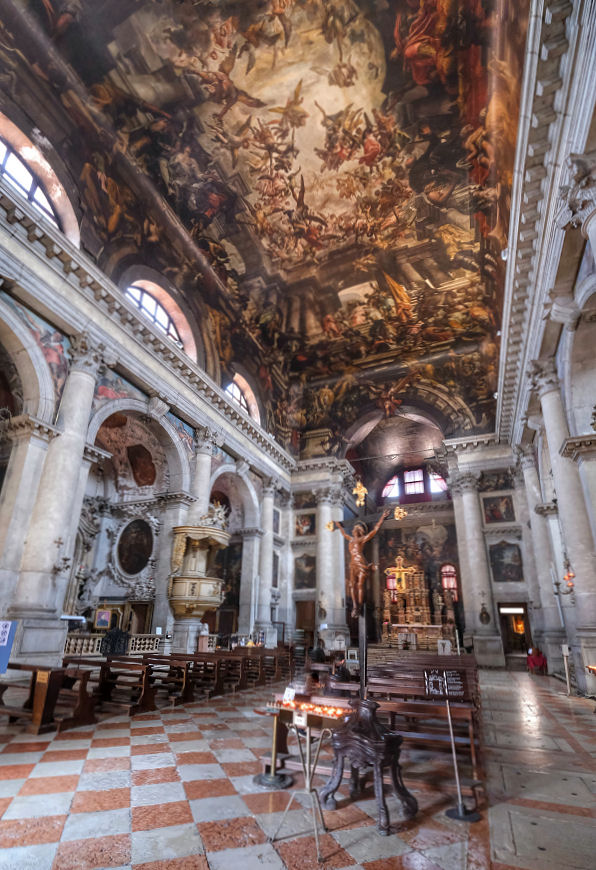
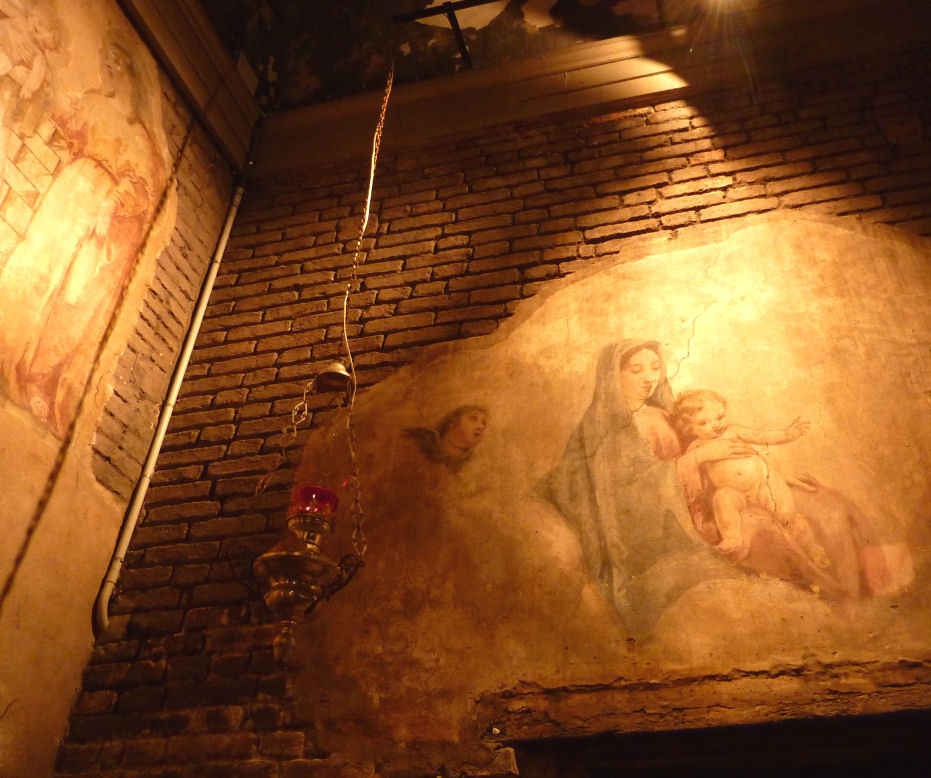
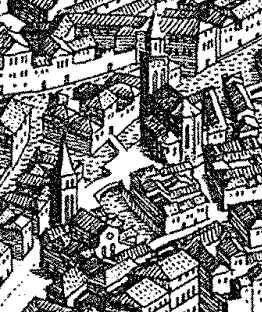
This detail from the Merian map of 1635 shows
the old San Pantalon facing the canal,
with
Santa Margherita (left foreground) still with its campanile.
|
